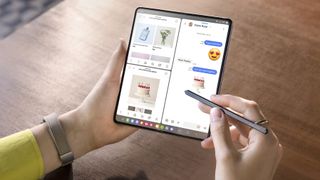Design for mobile: why we need to think beyond the West
To provide a better user experience we must take a step back and have a look what lies outside our boxes.

While I'm starting to write this, I'm sitting in a small town on Flores, Indonesia, working from a tethered local SIM and promising to never, ever again complain about a 'slow' LTE connection.
Before I start speaking about boxes and Asia, let's run through how we got here. Since the introduction of the iPhone in 2007, we've seen the mobile web growing and maturing; new techniques and approaches have started to evolve at a faster pace than ever before.
The rise of responsive web design has taught us many lessons, from the need to change long-established workflows to making assumptions about user intent; and about how to glean clues about a user's network speed from their screen size. We're still trying to work out how to handle responsive images, and encounter difficulties in establishing new best practices. In short, we have come across a lot of unknowns along the way.
Unknowns are here to stay
Even if there will be technical solutions to these current unknowns, there will be different and new challenges to overcome in the near future. This evolution won't stop. But we can try to work with these unknowns and optimise for better experiences.
The file size overload problem
Look at the page sizes of current (responsive) websites: while designing for performance has become a big topic, it seems only a small fraction of sites actually reflect effort in that direction. The likes of Apple's iPhone 5S site, with page sizes ranging from 5 to 11Mb, might make you think the opposite process was underway.
This becomes even clearer if we step out of our boxes, into other unknowns: different locations, developing countries, cultures, their users' infrastructure and technical limitations. Most of the tech world revolves around the US and Europe and that's where the centre of the web - let's even call it the driving force - lives.
Interestingly though, the bigger mass of actual internet users lives outside of these areas and is eager to view and consume content. Unfortunately a very large part of this massive group of users does not have the same access to the infrastructure we take for granted.
Often we don't consider the additional parameters outside our usual surroundings and our comfort zones. This is normal behaviour, since it's more difficult to relate to something we haven't seen or experienced, yet. Don't we have enough to think about already?
Network speeds
Many of us live in places where mobile network speeds aren't an issue and 3G or even LTE networks are common, but we should think about the locations that don't have such luxuries. While in the US or Europe about 80 per cent of mobile subscriptions are 3G or 4G, China's 3G coverage is moving up from around 15 per cent, with other developing countries around Asia even lower. China is working on 4G coverage and started rolling it out in 2013. For many other countries this will take much longer.
By keeping the limitations of other users in mind, not only will we improve their user experience; it will also result in a better experience for everyone else.
Mobile infrastructure
Many countries across Asia rely on mobile internet connections and don't have the alternative of desktop computers hooked up to fixed broadband lines at home. In China, this is mostly for the following reasons:
- Rural areas aren't as developed and educated as the cities. Besides the extra cost to buy a computer, learning how to use one represents, for many people, a barrier. They already know how to use their mobile phones, so why bother to spend extra money on something that they have to master using first?
- As wireless networks are easier to install and most rural areas don't have fixed broadband connections at all, mobile access is the only way to get connected. More than two-thirds of the 618 million total internet users in China are mobile web users. 3G subscribers reached 417.3 million in December 2013. In comparison, the total of US internet users is slightly above 300 million.
Device fragmentation
In the (mostly regulated) developed world, mobile device choice is limited. There are a handful of brands, offering a few devices each. There might be small differences between countries, and models may vary. Still, we're lucky to have the best devices out there available to us.
Imagine a place where regulations don't exist or, if they exist officially, nobody takes notice. Welcome to China. Besides the makes and models we know, there are many other brands out there, and every device has its clone – or different ones, with different levels of detail, build quality, spec and different flavours of OS. Most devices run a version of Android; an 'iPhone 5' running Android OS with the look of iOS isn't hard to find.
Many available smartphones, especially at the lower end, have less powerful hardware than we are used to. Software doesn't perform as flawlessly as we are used to. And in other developing countries, the selection may well be different again.
Mobile browser variety
This fragmentation of devices and operating systems presents a wide variety of browser choices, too. Across Asia, the top three browsers (in order of appearance) are Opera Mini, Android and UC Browser. Others include QQ Browser, Maxthon, Baidu, Puffin, Dolphin and Mercury, each with varying CSS support and their very own differences.
Building for GeoPerformance
When I talk to people, or attend conferences or meetups, it becomes clear that most live and think in their own world. We try to think beyond our own boxes, but there's usually some sort of priority, starting in rather close proximity. We tend to measure performance by our own standards, or by some average fairly close to them. Then it hits you, next time you go on holiday: the super fast site you built the other week suddenly performs poorly and takes way too long to load.
I started to call this GeoPerformance: considering performance at a global level. The aim should be to optimise web performance for the best possible user experience, regardless of location, infrastructure and network speed. There will always be challenges, but the emphasis should lie on aim, which requires you to at least take different scenarios and use cases into consideration.
Awareness builds a better web
There are many factors that affect a user's experience on the web; sadly we probably won't be able to solve all of these problems at once. But by starting and trying to think outside our boxes, by forgetting about our known constraints and remembering that our users' experience might not be the same as our own, we will create a better web for these users. And with it for everybody else.
Words: Holger Bartel Illustration: Ben Mounsey
Designer and dev Holger Bartel runs foobartel Ltd in Germany and Hong Kong. He founded HK Open Device Lab, speaks at events and loves travelling. This article originally appeared in net magazine issue 255.

Thank you for reading 5 articles this month* Join now for unlimited access
Enjoy your first month for just £1 / $1 / €1
*Read 5 free articles per month without a subscription

Join now for unlimited access
Try first month for just £1 / $1 / €1
Get the Creative Bloq Newsletter
Daily design news, reviews, how-tos and more, as picked by the editors.
The Creative Bloq team is made up of a group of design fans, and has changed and evolved since Creative Bloq began back in 2012. The current website team consists of eight full-time members of staff: Editor Georgia Coggan, Deputy Editor Rosie Hilder, Ecommerce Editor Beren Neale, Senior News Editor Daniel Piper, Editor, Digital Art and 3D Ian Dean, Tech Reviews Editor Erlingur Einarsson and Ecommerce Writer Beth Nicholls and Staff Writer Natalie Fear, as well as a roster of freelancers from around the world. The 3D World and ImagineFX magazine teams also pitch in, ensuring that content from 3D World and ImagineFX is represented on Creative Bloq.




